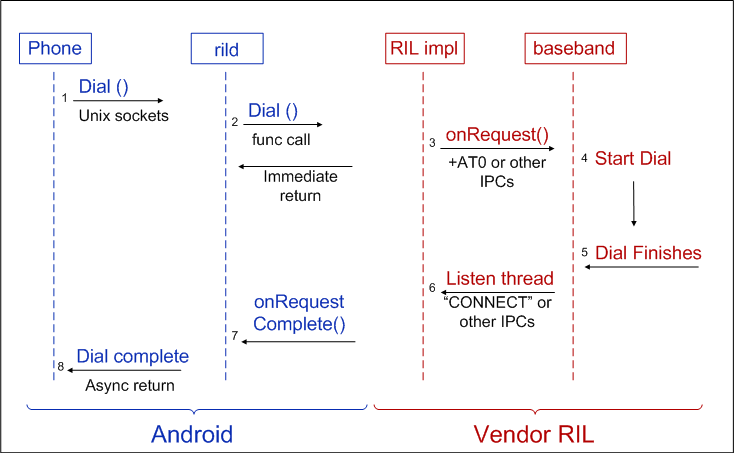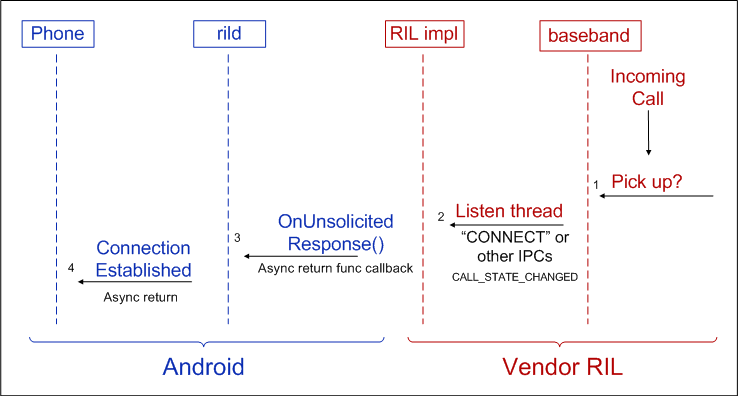Android RIL学习
Android RIL学习
1.Android RIL概念
Android RIL是基于telephony 服务和raido 硬件层的抽象层。Android的rild库是介于HAL接口与baseband modem之间,它提供了语音、数据、短信、SIM卡管理以及STK应用的功能。它把标准的 GSM27.007中常用的如dial这些做主动请求的操作称之为request,一共75个;另外一类GSM模块主动上报的例如信号强度、基站信息等, 称之为unsolicited response,一共17个。开发模式上,需要针对不同的GSM模块进行不同的GSM驱动开发,公用的部分google做 好了,特定的部分需要自己去定制。如下是Android RIL架构图。
2.代码结构
Android2.2中,RIL的代码在hardware目录下,主要包括libril,include,rild,reference-ril,reference-cdma-sms四个目录,编译后生成rild应用程序(守护进程,放在target device的/system/bin下),libril.so(RIL动态链接库,放在device的/system/lib目录下)和libreference-ril.so(RIL参考库,放在device的/system/lib下)。
3.RIL初始化
1) Init.rc执行rild,并创建两个socket:/dev/socket/rild和/dev/socket/rild-debug
service ril-daemon /system/bin/rild
socket rild stream 660 root radio
socket rild stream 660 radio system
2) 进入rild.cpp的main函数,读取rild.lib的path和rild.libargs系统属性,确定厂商的RIL库和初始化参数。
3) 执行RIL_startEventLoop开启事件队列,进行事件监听。这个函数会建立s_tid_dispatch线程。
4) 加载厂商的RIL库,调用RIL_Init初始化RIL,建立s_tid_mainloop线程。在该线程主循环中会调用at_open建立另一个线程s_tid_reader。
5) 调用RIL_register建立vender ril和ril库之间的联系。获取init.rc中建立的两个socket(rild,rild-debug),进行侦听,并加入消息事件循环中(s_tid_dispatch负责轮询分发)。
4.RIL的事件机制
ril_event.h/cpp对linux常用的select机制进行了简单封装,实现多路复用,以及事件到处理函数的映射。通过阅读rid_event.h的代码就可以理解这个机制所要提供的功能。
ril_event是个带有链表行为的结构体,而且是双向链表,它的主要成员是fd(要轮询的IO,文件,管道,socket等),func(处理事件的回调)。
typedef void (*ril_event_cb)(int fd, short events, void *userdata);
struct ril_event {
struct ril_event *next;
struct ril_event *prev;
int fd;
int index;
bool persist;
struct timeval timeout;
ril_event_cb func;
void *param;
};
提供了六个接口:
// Initialize internal data structs
void ril_event_init();
// Initialize an event
void ril_event_set(struct ril_event * ev, int fd, bool persist, ril_event_cb func, void * param);
// Add event to watch list
void ril_event_add(struct ril_event * ev);
// Add timer event
void ril_timer_add(struct ril_event * ev, struct timeval * tv);
// Remove event from watch list
void ril_event_del(struct ril_event * ev);
// Event loop
void ril_event_loop();
使用之前调用ril_event_init,增加一个io的时候首先初始化事件ril_event_set,然后加入到列表ril_event_add,轮询用ril_event_loop,逻辑非常清晰。关键是在ril_event_set的时候把fd和回调对应上。timer理论上不属于io操作,所以没有所谓的fd,增加timer事件用ril_timer_add,其它的类似,本质上还是事件与回调的对应机制。
至于实现细节,完全可以不关心,有兴趣的话就看代码,很简单,搞清楚readFDS,watch_list,timer_list,pending_list就差不多了。
从这个机制上看,调用event_loop的线程将执行事件分发的任务。因为在add,remove操作中有mutex进行保护,所以这个事件机制支持重入。
在rild的初始化中,会执行RIL_startEventLoop,启动s_tid_dispatch线程来进行事件轮询,所以其它的地方只要考虑事件的增加和删除就可以了。
全局搜索ril_event_set,就可以知道在rild上都有什么事件在跑了。
1) S_listen_event(s_fdListen,listenCallback):名为rild的socket(init.rc建立的),主要用来监听上层的(RIL-JAVA)客户端连接请求,建立socket连接(s_fdCommand),并新增s_commands_event来监听s_fdCommand。
2) s_commands_event(s_fdCommand,ProcessCommandsCallback):listen的时候建立的socket,用来从客户端接收StreamRecord(实际上就是Dial,Hang等RIL指令),使用ProcessCommandBuffer处理数据。
3) s_debug_event(s_fdDebug,debugCallback):名为rild-debug,调试用的request&response通道,用于radiooptions这个调试工具。
4) s_wakeupfd_event(s_fdWakeupRead,processWakeupCallback):无名管道。仅仅为了开始时wake up这个事件轮询。
5) timer event
5.RIL的交互流程
RIL的通讯分成两种:1)Solicited commands:RIL lib发起的主动调用,比如拨号2)Unsolicited responses:从baseband过来的通知消息,比如新短信到来。前者在类似协议上的request-confirm机制,后者类似Indication-response机制。
5.1 Solicited Commands
1) RIL.java是FrameWork中Telephony服务的提供者,是Java中电话系统的起点,在这个文件的RIL class中封装了RIL所提供的command,实现了CommandsInterface。
getIccCardStatus
supplyIccPin
supplyIccPuk
changeIccPin
changeBarringPassword
getCurrentCalls
getDataCallList
dial
……
2) 以dial为例,首先调用RILRequest.obtain打包请求,然后再调用RIL::send将消息发送到RILSender的消息队列中。
3) RILSender是个handler类,会在handleMessage中处理发送消息请求。它会将消息发送到同“RIL”成功建立的socket中。
4) 如6.4节所述,此时rild和JAVA上层建立的socket为s_fdCommand。通过事件轮询机制轮询到有数据来临的时候,会调用processCommandsCallback来处理数据。
5) 调用processCommandBuffer。
6) 在ProcessCommandBuffer中,通过ril_commands.h里面的消息及函数映射,对应于RIL_REQUEST_DIAL的函数为dispatchDial。
7) 在dispatchDial中,调用RIL_Register注册的函数onRequest,也就是reference-ril.c中的onRequest。
8) 调用requestDial。
9) 调用atchannel.c的at_send_command来发送at命令。
10) 调用RIL_onRequestComplete立即回应调用者,不管调用成功还是失败。这时候会调用rild的回调函数RIL_onRequestComplete,该回调在RIL_Init的时候注册,在ril.cpp中实现。
11) 在RIL_onRequestComplete中组装响应,调用sendResponse。
12) 调用sendResponseRaw。
13) 往和JAVA上层建立的socket中写数据。
14) JAVA层RIL.java中,会起一个RILReceiver线程来接收数据。
15) RILReceiver接收到的消息,调用RIL的readRilMessage读取数据。然后调用processResponse处理数据。
16) 调用processSolicited。
5.2 Unsolicited Response
1) 在RIL_Init中传入参数s_device_path,是同modem通讯的设备路径,一般是串口(ttyS),在模拟器中,用qemud 的socket模拟。
2) RIL_init启动s_tid_mainloop,用于打开通信信道(比如串口,或者模拟器的qemu socket),并启动s_tid_reader接收消息。
3) S_tid_reader线程从at channel收到Unsolicited reponses,调用Unsolicited handler(在at_open的时候指定为reference-ril.c的onUnsolicited)。
4) ril.h定义了一系列宏,对应各个Unsolicited response,从RIL_UNSOL_RESPONSE_BASE开始。ril_unsol_commands.h中每个unsolicited repsonse对应一个处理函数。RIL_UNSOL_CALL_STATE_CHANGED对应responseVoid,封装返回给JAVA层的消息。
5) 调用sendResponse给s_fdCommand发消息。
6) JAVA层的RILReceiver收到消息,调用processResponse。
7) 对应于Unsolicited response,调用processUnsolicited。
6.Radiooptions
这是一个调试程序,可以在控制台启动这个程序,在不开启ui的情况下,调试ril。
# radiooptions
Usage: radiooptions [option] [extra_socket_args]
0 - RADIO_RESET,
1 - RADIO_OFF,
2 - UNSOL_NETWORK_STATE_CHANGE,
3 - QXDM_ENABLE,
4 - QXDM_DISABLE,
5 - RADIO_ON,
6 apn- SETUP_PDP apn,
7 - DEACTIVE_PDP,
8 number - DIAL_CALL number,
9 - ANSWER_CALL,
10 - END_CALL
7.Extend Readings
http://blog.csdn.net/maxleng/archive/2010/05/14/5593759.aspx
http://www.netmite.com/android/mydroid/development/pdk/docs/telephony.html#androidTelephonyRILImplementing


